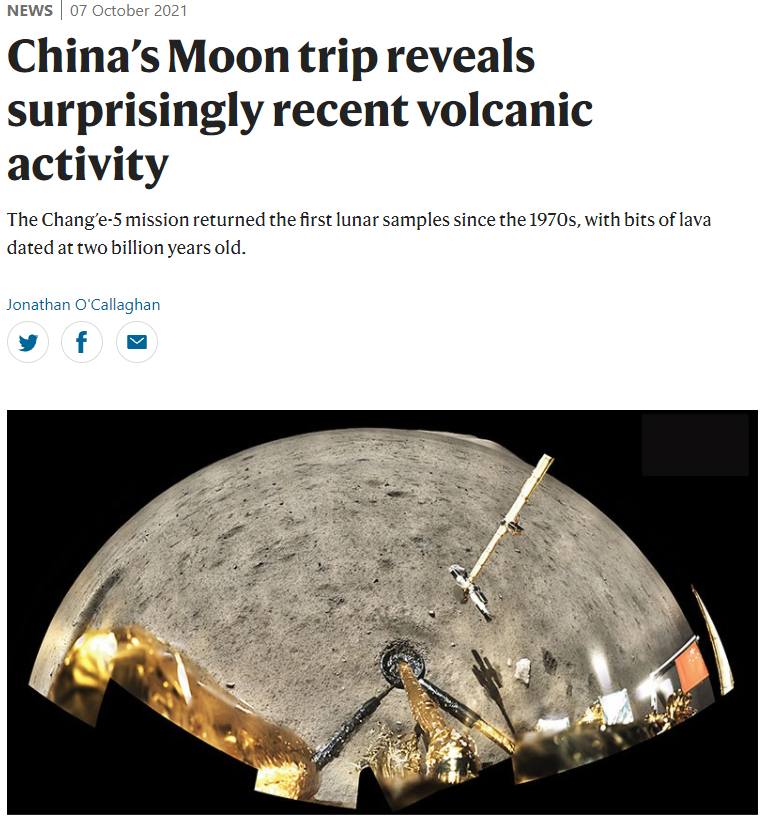물리News

<중국의 달 탐사선 change-5호의 어안뷰>
The first samples to be brought back from the Moon in half a century — and the first ever by a Chinese mission — carry evidence of the most recent lunar lava ever analysed. Researchers used only tiny fragments from the 2 kilograms of rock returned last December by the Chang’e-5 lander to confirm predictions about the Oceanus Procellarum region, where the spacecraft had landed.
At about two billion years old, the samples reveal volcanism that is at least one billion years younger than any found by NASA’s Apollo astronauts or by the Soviet Union’s uncrewed Luna missions in the 1960s and 1970s. “This is the youngest-ever lava flow dated from the Moon,” says Katherine Joy, a planetary scientist at the University of Manchester, UK, and a co-author of the study, published in Science on 7 October1. The findings fill a vital gap in the Moon’s geology, and will also help scientists to understand the history of other Solar System bodies.
China achieved a historic feat when its Chang’e-5 lander touched down on the Moon on 1 December 2020, scooped up samples of the lunar surface and lifted off again two days later. It then performed an automated rendezvous with its mother ship in lunar orbit, which subsequently flew back to Earth. A re-entry capsule carrying the samples landed in China’s Inner Mongolia region on 16 December.
The mission’s target, Oceanus Procellarum on the Moon’s near side, is a region of interest to scientists because it is thought to contain young solidified lava, an indication of relatively recent volcanism on the Moon.
Based on samples returned by the Apollo and Luna programmes, scientists already had evidence for volcanic eruptions on the Moon stretching back more than 4 billion years, with the majority occurring between 3.8 billion and 3 billion years ago. But no mission had landed in an area as young as Oceanus Procellarum — Latin for ‘Ocean of Storms’ — which stretches 2,500 kilometres from north to south. Lunar scientists were eager to try to find evidence of more recent volcanism in a region such as this. “I was very pleased with the selection of this landing site,” says Harald Hiesinger, a planetary scientist at the University of Münster in Germany.
Lunar lava
As on Earth, lunar volcanism is thought to occur when magma is pushed up to the surface and erupts, leaving ‘seas’ (maria in Latin) of basaltic rock on the surface, which are easily seen from Earth. In Oceanus Procellarum, nearly 2,000 cubic kilometres of basaltic magma are thought to have spewed on to the surface, a big eruption by lunar standards.
The Chang’e-5 lander used a scoop and a drill to collect samples here, at least some of which are now known to be basaltic rock, and their age was determined by radioactive dating.
The findings provide a vital data point about the history not just of the Moon, but of the wider Solar System too. By knowing the exact age of Oceanus Procellarum, and matching that to the number of its craters — which accumulate over time as impacts occur — scientists can infer that locations on other worlds, such as Mars, with similar numbers of craters are of a comparable age. This process, known as crater counting, has so far relied almost entirely on the dating of lunar samples collected by the Apollo missions, leaving a huge gap in the timeline between one and three billion years ago. “It’s absolutely essential to get more data points,” says Ian Crawford, a planetary scientist at Birkbeck, University of London. “That’s what this paper has done.”
Unsolved puzzle
What’s unclear at the moment, however, is what would have driven volcanism on the Moon at the time when Oceanus Procellarum formed. By this time, the Moon had begun to cool, and “the amount of magma being generated dropped off quickly”, says Joy. One possibility is that residual radioactive uranium, thorium and potassium in the Moon’s interior provided the heat necessary for late volcanism to occur. But the Chang’e-5 samples do not show an abundance of such radioactive elements. “This is really a puzzle,” says Joy.
Another explanation might be that the tidal pull of Earth’s gravity gave the Moon the necessary heat. “Two billion years ago, the Moon was significantly closer to Earth, maybe halfway closer than it is now,” says Alexander Nemchin, a planetary scientist at Curtin University in Perth, Australia, and a co-author of the study. “So this effect was probably amplified quite significantly.” However, it’s not clear why this would produce localized heating in regions like Oceanus Procellarum, and not much more widely across the lunar surface.
There could be even younger areas to be found on the Moon. Hiesinger, who has contributed to much of the crater-counting work, says that some regions appear to be just a few tens or hundreds of millions of years old — which poses a conundrum. “That would mean the Moon was volcanically active until about 50 million years ago,” he says, which seems “highly unlikely”.
 이전글 이전글 |
[물리뉴스] lhc(대형 입자충돌기)의 magnet training을 통한 양성자 에너지증가2021-10-01 |
|---|---|
다음글  |
[물리뉴스]물리학과 10학번 강지은 휴온스 LPBA 챔피언십 우승... 2년 2개월 만에 통산 2승2021-11-23 |









